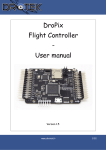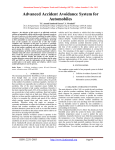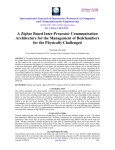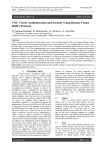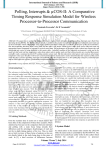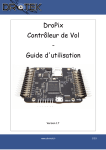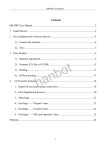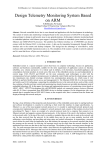Download Portable Roadside Sensors for Vehicle Counting
Transcript
Portable Roadside Sensors for Vehicle Counting, Classification, And Speed Measurement Rollakanti Raju Professor Department of ECE MLRITM, Hyderabad, Telangana, India. Abstract: Life is too precious than anything in the world. Daily 40% of the deaths were caused to the road accidents across the globe. This should be prevented by taking intensive measures using emerging trends of technology. Portable road side systems were to be established for monitoring the roads using cuttingedge technologies. Portable road side systems will communicate with the traffic system if any emergency caused. This has to alert the driver if the speed of vehicle is greater than the speed limit. In order to demonstrate this, I’ve used ARM7 (LPC 2148) and 8051 Controller, the communication between these two has done through Master - Slave. RFID Technology is used to count the number of vehicles, and classifications of vehicles are also done through RFID technology. GSM Module is used to send SMS when the vehicle speed is greater than the speed limit. The speed calculation is done through a pair of sensors connected to the system. Keywords— ARM7, RFID Technology, GSM I.INTRODUCTION Portable Road Side Systems are a type of network in which vehicles and roadside units are the communicating nodes, providing each other with information, such as safety warnings and traffic information. As a cooperative approach, vehicular Sangem Saikrishna M.Tech Student Department of ECE MLRITM, Hyderabad, Telangana, India. communication systems can be more effective in avoiding accidents and traffic congestions than if each vehicle tries to solve these problems individuality. Generally, vehicular networks are considered to contain two types of nodes: vehicle and roadside stations. Both are dedicated short-range communications devices. DSRC works in 5.9 GHz bandwidth of 75 MHz and approximate range of 1000m. The network should support both private data communications and public communications but higher priority is given to public communications. Vehicular communications is usually developed as a part of intelligent transportation systems (ITS). ITS seeks to achieve safety and productivity through intelligent transportation which integrates communication between mobile and fixed ones. To this end, ITS heavily relies on wired and wireless communications. II.SYSTEM ARCHITECTURE The system architecture of this proposed system is divided into two different and independent blocks. ARM7 END: Hardware implementation for this proposed system is shown below with the simple blocks. Power Supply block is designed and developed to generate power source for the ARM processor and its relevant components. Reset Circuit is designed and Page 1129 developed to reset the program whenever necessary and interfaced to the ARM processor for greater stable response. Clock Circuit is designed and developed to generate oscillations and interfaced to the ARM processor for needy response. LCD Display is interfaced to the ARM processor for displaying the status of the system for better understanding. RFID Reader is connected to ARM processor for identifying the vehicle and also to count the number of vehicles running on the road. The same information is fed to slave controller (8051). III.IMPLEMENTATION HARDWARE: In hardware implementation, ARM processor plays a key role in monitoring and controlling the security system. Low-power consumption ARM processor (LPC2148) operating at 3.3V, 50uA is designed and mounted on a PCB along with Reset Circuit and a Clock Circuit. LPC2148, a 32-bit microcontroller with advanced RISC architecture and having 48 GPIO lines with a program memory of 32KB and a data memory of 512Bytes. Figure – 1: Block Diagram of ARM7 END 8051 END: At 8051, pair of sensors was interfaced to the slave controller for calculating the speed of vehicle passed. GSM module is also interfaced to the slave controller for communicating with the end user. LCD Display is interfaced to slave controller for displaying status of the project. Reset Circuit and clock circuit were also interfaced to the slave controller for resetting and generating the clock oscillations respectively. Figure – 2: Block Diagram of 8051 END Figure – 4: ARM Overview [LPC2148] Figure – 5: LPC2148 Development Board Page 1130 Here, in the above figure the clock circuit and reset circuits were assembled along with the LCD display circuit. A 16 X 2 LCD display is used for displaying the status of the system. RFID Reader is interfaced to ARM7 at UART port and each vehicle is equipped with RFID tag. The RFID Reader is a UART module and is connected at 0.0, 0.1 of ARM7. Figure – 6: RFID Reader LCD: LCD has used in this project for display status of the system. Interfacing LCD to LPC 2148 has shown below: Figure – 7: LCD Display Interfacing IR Sensors: For optical sensing and optical communication, photo optics technologies are used in the near infrared region as the light is less complex than RF when implemented as a source of signal. Optical wireless communication is done with IR data transmission for short range applications. The working of any Infrared sensor is governed by three laws: Planck’s Radiation law, Stephen – Boltzmann law and Wien’s Displacement law. Planck’s law states that “every object emits radiation at a temperature not equal to 00K”. Stephen – Boltzmann law states that “at all wavelengths, the total energy emitted by a black body is proportional to the fourth power of the absolute temperature”. According to Wien’s Displacement law, “the radiation curve of a black body for different temperatures will reach its peak at a wavelength inversely proportional to the temperature”. The basic concept of an Infrared Sensor which is used as Obstacle detector is to transmit an infrared signal, this infrared signal bounces from the surface of an object and the signal is received at the infrared receiver. There are five basic elements used in a typical infrared detection system: an infrared source, a transmission medium, optical component, infrared detectors or receivers and signal processing. Infrared lasers and Infrared LED’s of specific wavelength can be used as infrared sources. The three main types of media used for infrared transmission are vacuum, atmosphere and optical fibers. Optical components are used to focus the infrared radiation or to limit the spectral response. Optical lenses made of Quartz, Germanium and Silicon are used to focus the infrared radiation. Infrared receivers can be photodiodes, phototransistors etc. some important specifications of infrared receivers are photosensitivity, detectivity and noise equivalent power. Signal processing is done by amplifiers as the output of infrared detector is very small. The principle of an IR sensor working as an Object Detection Sensor can be explained using the following figure. An IR sensor consists of an IR LED and an IR Photodiode; together they are called as Photo – Coupler or Opto – Coupler. An infrared sensor emits and/or detects infrared radiation to sense its surroundings. Page 1131 The architecture of 8051 has shown below: Figure – 8: IR sensor 8051 End: 8051 is an 8-bit processor, meaning that the CPU can work on only 8 bits of data at a time. Data larger than 8 bits has to be broken into 8-bit pieces to be processed by the CPU. 8051 is available in different memory types such as UV-EPROM, Flash and NVRAM.8K Bytes of Re-programmable Flash Memory.RAM is 256 bytes.4.0V to 5.5V Operating Range.Fully Static Operation: 0 Hz to 33 MHz’sThreelevel Program Memory Lock.256 x 8-bit Internal RAM.32 Programmable I/O Lines.Three 16-bit Timer/Counters.Eight Interrupt Sources.Full Duplex UART Serial Channel.Low-power Idle and Powerdown Modes.Interrupt recovery from power down mode.Watchdog timer.Dual data pointer.Power-off flag.Fast programming time.Flexible ISP programming (byte and page mode). Pin diagram of 8051 has given below: Figure – 9: 8051 Pin Diagram Figure – 10: 8051 Architecture PC/Laptop was interfaced at UART0 of LPC2148 as per Figure – 7. Motor was interfaced to L293D (Motor Driver) at P0.3 – P0.5 of LPC2148 as per Figure – 8 which enables the locker action. GSM Module was interfaced to UART1 for SMS communication. Keypad (4 * 3) was interfaced at P0.16 – P0.23 of LPC2148. LCD Display (16 * 2) was also interfaced at P1.6 – P1.22 of LPC2148. Reset Circuit and Clock Circuits were interfaced at RST, XTAL1, and XTAL2 of LPC2148. Figure – 11: GSM Module Page 1132 Schematic Diagram for this project has shown below: Figure – 13: Flow Chart Figure – 12: Schematic Diagram SOFTWARE: Here, to program ARM processor KeiluVision 4 was used as a cross-compiler and Flash Magic was used as a programmer. ALGORITHM & FLOWCHART ALGORITHM: Step – 1: Initialize ARM, LCD, RFID and GSM Module. Step – 2: Wait until you see READY on LCD. Step – 3: Show the RFID Tag to the reader, then it reads the data from tag. The same data is communicate with the 8051 using bridge Step – 4: If it is a small vehicle, then increment the count1 or if it is a large vehicle, then increment the count2. Step – 5: Check the speed of that vehicle using IR Sensors, if it exceeds the fixed speed limit then a fine will be fined and a feedback will be sent to the owner/driver. Step – 6: Repeat Step – 3 to Step – 5 until the power goes off FLOWCHART: The flowchart of this paper is shown below: IV.RESULTS Figure – 14: Final Prototype Figure – 15: RFID Reader Page 1133 Figure – 19: RFID Data Figure – 16: Sensor 1 Figure – 20: RFID Data 1 Figure – 17: Sensor 2 Figure – 21: RFID Tag 2 Figure – 18: GSM Module Figure – 22: RFID Tag 3 Page 1134 REFERENCES [1]http://www.engineersgarage.com/armprojects/introduction-to-arm-microcontroller-lpc2148 [2] https://www.pantechsolutions.net/microcontrollerboards/user-manual-arm7-lpc2148-development-kit Figure – 23: RFID Tag 4 [3] http://www.nex-robotics.com/lpc2148development-board/arm7-lpc2148-developmentboard.html [4]http://www.mikroe.com/chapters/view/65/chapter2-8051-microcontroller-architecture/ [5]https://www.pantechsolutions.net/microcontrollerboards/gsm-interfacing-with-lpc2148-arm7-primer [6]http://www.zilogic.com/blog/tutorial-nuttx-rfid.html Figure – 24: SMS Feedback V.CONCLUSION A Portable Road Side Communication System is designed and proposed for better safety in vehicular connectivity. This system will give you the feedback of every instant with a simple SMS. ACKNOWLEDGEMENT I would like to express my special thanks of gratitude to Prof. Rollakanti Raju,K. N. BHUSHAN, Assoc. Prof & HOD ECE, Marri Laxman Reddy Institute of Technology& Management as well as our Principal Dr. K. Venkateswara Reddy, M. Tech., Ph.D., MISTE, who gave me the golden opportunity to do this wonderful project on the topic (Internet of Things), which also helped me in doing a lot of Research and i came to know about so many new things. We are really thankful to them. And, secondly i would also like to thank my parents and friends who helped me a lot in finalizing this project within the limited time frame. [7http://www.engineersgarage.com/microcontroller/80 51projects/distance-measure-IR-ADC0804-AT89C51circuit [8]http://www.nrdcentre.com/index.php?route=product /product&product_id=78 [9]https://madresearch.wordpress.com/2013/09/03/inte rfacing-gsm-with-arm7-lpc2148/ [10] http://www.keil.com/forum/20111/gsminterfacing-with-arm7/s Author Details Prof. Rollakanti Raju has completed B.E from Andhra University and M.Tech from JNTU Ananthapur in DSCE. He is pursuing Ph.D in the area of VLSI from JNTUH. He has guided over 50 projects. Mr.S.Saikrishna had completed B.Tech in ECE from Aizza College of Engineering and Technology. He is pursuing M.Tech in Embedded Systems from MLRITM College. Page 1135







